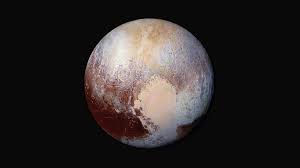PLUTO
- Beyondthestarss
- Apr 8, 2023
- 3 min read
“The Known Dwarf Planet : Pluto”

• It was discoured by Klyde Tombaught on 18th February 1930.
• He discovered it in Lowell Observatory in Hagstaff, Arizona.
•Percival Lowell owned Lowell Observatory.
• They announced the discovery of Pluto on March 13, 1930 which was both the 149th anniversary of the discovery of Uranus and what would have been Percival Lowell's 75th birthday.
• Headlines (news) - The New York Times ran the banner headline: Winth Planet Found at Edge of Solar system: First found in 84 years.
• 11 year old Venetia Burney, a school girl in England, suggested the name "Pluto", after the Roman ruler of the underworld. She sent it through a telegram to the Lowell Observatory.
• Pluto takes about 248 earth years to make it just once about the Sun.
• Pluto is 3,670,050,000 miles away from the sun. At that distance, the Sun's gravitational hold is much weaker and planets orbit much slower.
• Pluto takes 6.4 days( 6.39 days) to complete one revolution.
• On 22nd June 19 28, James Christy and Robert Harrington discovered the largest of Pluto's five moon, Charon, which was only about six miles from where Pluto itself was discovered at Lowell Observatory. It had 6.39 day just like Pluto.
• The moon was named Charon (most often pronoured "Sharon”) after the mythical Greek ferryman who carried the dead to the Plutonian underworld.
• The mass of Pluto is 1.30900 x 10^22, which is about 1/ 400th the mass of Earth.
• Compared to Pluto Charon was huge, with a mass almost 10 percent of Pluto's: The pair literally farmed a double planet.
• Pluto orbits at an average distance some forty times farther from the Sun than Earth.
• The lightning and dimming of Pluto, occurs precisely every 6.39 Earth days.
• As technology improved in the early 1970s, the planetary astronomers succeeded at determining its brightness as a function of wavelength. This revealed that its overall color is a reddish hue.
• In 1976, planetary astronomers at a mountaintop obseruatory in Hawaii discovered the subtle spectral fingerprints of methane frost (frogs natural gas) on Pluto's surfer. This prowded the first evidence that Pluto's surface is made out of truly exotic stuff.
• It takes 5 hours for the sun's light to reach Pluto.
Physical Features of Pluto: -
Surface. Pluto’s surface is characterized by mountains valleys, plain and creaters. The temperature on Pluto can be as cold as -375 to -400 degree Fahrenheit (-226 to -240 degrees Celsius). Pluto's tallest mountains are 6,500 to 9,8000 feet (2 to 3 km in height).
Pluto is dwarf planet that lies in the Kuipher Belt, an area full of icy bodies and other dwarf planets out past Neptune. Pluto is very small, only about half the width of the United States and its biggest moon Charon is about half the size of Pluto.
Atmosphere. Pluto's atmosphere is roughly 90% Nitrogen, and 10% other complex molecules such or methane and carbon monoxide.
Layers of Pluto : -
Top layer - It is composed of a mixture of frozen nitrogen, methane, and carbon monoxide ices.The dwarf planet also has polar caps and regions of frozen methane and nitrogen.
Inner layer - It has a rocky core surrounded by a mantle of water ice. The core is comprised of mostly iron and rock.
Atmosphere Layers of Pluto :-
The atmosphere of Pluto is the tenuous layer of gases surrounding Pluto. It consists mainly of nitrogen, with minor amounts of methane, and carbon monoxide, all of which are vaporized from their ices on Pluto's surface.
* These all information about Pluto was known because of the space Probe New Horizon.
All about New Horizon : -
New Horizons is an interplanetary space probe that was launched as a part of NASA's New Frontiers program. Engineered by the John Hopkins University Applied Physics Laboratory (APL) and the Southwest Research Institute (SwRI), with a team led by Alan Stern, the spacecraft was launched. In 2006 January 19 with the primary mission to perform a flyby study of the Pluto system is 14 July 2015, and a secondary mission to fly by and study one or more other Kuiper Belt objects (KBOS) in the decade to follow, which became a mission to 486958 Arrokoth. It is the fifth space probe to achieve the escape velocity needed to leave the Solar System.
The New Horizons helped us know about not only Pluto but also 3 more thing:
*Fly by of 132524 APL - 13th June 2006.
*Fly by of Jupiter - 28th February 2007.
*Fly by of Pluto - 14th July 2015.
*Fly by of 486958 Arrokoth - 1st January 2019.
"The New Horizons was a 14 year mission to explore our Salar system.”
If you what to know more about Pluto I suggest You To Read The Book “ Chasing New Horizons” by Alan Stern and David Grinspoon.





Comments